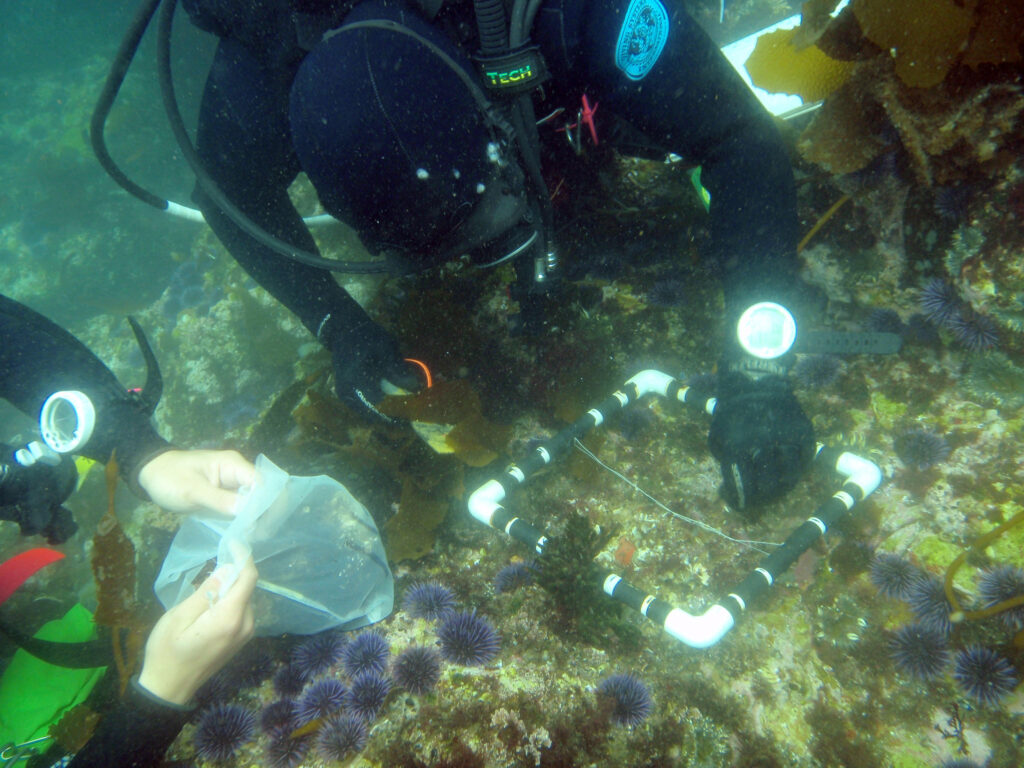Sea urchins are a key but often destructive part of the kelp forest ecosystem along the Pacific Coast, and in boom years can often turn these forests into barrens devoid of marine life. But it remains a mystery what causes urchin boom and bust cycles and how sea urchins are affected by increasingly common marine heat waves.
A new study by marine biologists at the University of California, Berkeley, now suggests that sea urchin populations along the Pacific Coast are more susceptible to heat waves than once thought, because the animals ramp down reproduction at temperatures substantially below levels that kill them.
As ocean temperatures rise with global warming, the lower threshold means that crashing sea urchin populations could become more frequent than biologists have predicted, affecting the coastal environment that relies on a balance between kelp and urchins for a healthy ecosystem.
Understanding what leads to population crashes and explosions could help biologists and commercial urchin harvesters plan better to manage and sustain populations.
"We show that collapses in the abundance of young - in this case sea urchins - that we've seen over the past four decades that are associated with marine heatwaves are not occurring due to lethal stress, but instead, in part, due to suppression of reproduction by temperature," said Daniel Okamoto, lead author of the study and a UC Berkeley assistant professor of integrative biology. "The implications are that a warming planet may bring about collapses in wild populations well before we anticipate because sub-lethal stress can shut down key processes like reproduction."
The findings suggest that other marine organisms, ranging from abalone and corals to oysters and mussels, may similarly see reproductive suppression at sublethal temperatures, he noted.
The study, published last week in the journal Communications Biology, a Nature journal, was conducted in cooperation with the Hakai Institute in British Columbia, Canada, and UC Davis's Bodega Marine Laboratory in California.
More sea urchins mean less kelp
Over the past 35 years, marine biologists have charted changes in sea urchin populations along the Pacific coast following marine heat waves, but the pattern has been baffling. In Southern California, populations crash in the year after heat waves, but along the Northern California Coast, they actually increase. Hypotheses abound, but biologists have focused primarily on how heatwaves directly affect larvae and their food supplies and a potential increase in disease.

Clint Nelson/UC Santa Barbara
"Even in the warmest years, the adults will be thriving in Southern California, the larvae are out in the plankton in the winter, and it just never gets to the temperatures that we would think would be too stressful for those larvae. So, it was a bit of a conundrum," Okamoto said.
Urchin populations have a large impact on the coastal environment because in boom years they decimate kelp forests, creating barren waters that lead to the starvation of other species that depend on kelp. An abundance of larval sea urchins one year harbingers a decline in kelp forests the following year.
Part of the difficulty in studying the population swings is that species like sea urchins produce lots of eggs; the resulting microscopic larvae disperse into the open sea for several weeks to several months, where they feed on phytoplankton.
"We have no idea where they go or where they come from, and thus no way to understand why we see the patterns that we do," Okamoto said.

Clint Nelson/UC Santa Barbara
Once the larvae return to shore, they settle on rocks and kelp as mini-urchins the size of a grain of sand, feeding on algal scum. A year or more later, they emerge onto reefs much larger and ready to eat the larger kelp.
"In Southern California, that process was really correlated with marine heatwaves in El Niño years. Anytime you get a warm water event, we'd see the disappearance of a lot of those new urchin babies raining out of the plankton. Basically, a disappearance of the larval supply," he said.
To clarify why, Okamoto and his colleagues looked at 30 years of data on coastal temperatures and larval and adult populations of purple sea urchins. They subsequently conducted experiments in the laboratory to test the response of both red and purple sea urchins to sustained elevated temperatures for various lengths of time.
They found that, although adults and larvae begin to die at temperatures of 23 to 25 degrees Celsius (73-77°F) and 20 to 22 degrees Celsius (68-73°F), respectively, the adult females stopped producing eggs at lower temperatures, around 18 degrees Celsius. This was true even when food was abundant and the females had healthy gonads.
The timing of the heat wave is also critical, Okamoto said. Summer marine heat waves in Southern California are not as much a problem as heat waves that continue into the fall and early winter - September to December - when adult females should normally be producing eggs.

Clint Nelson/UC Santa Barbara
He noted that marine warming in Northern California through British Columbia doesn't typically reach temperatures that affect reproduction in the same way. Oddly enough, unlike in southern California where heatwaves decrease larval supply, the heatwave-related larval increases in northern California contribute to overgrazing of kelp forests.
This study was funded by the Hakai Institute, Tula Foundation, U.S. National Science Foundation (483 2023649, 2023664) and Santa Barbara Coastal Long Term Ecological Research program. Coauthors include Maya Mustermann and Sam Karelitz of UC Berkeley, Brenna Collicutt, Iria Gimenez, Kate Rolheiser, Evan Cronmiller, Megan Foss and Natalie Mahara of the Hakai Institute, Dan Swezey and Laura Rogers-Bennett of Bodega Marine Lab, Stephen Schroeter of UC Santa Barbara and Nathan Spindel and Rachele Ferraro of Florida State University in Tallahassee.






